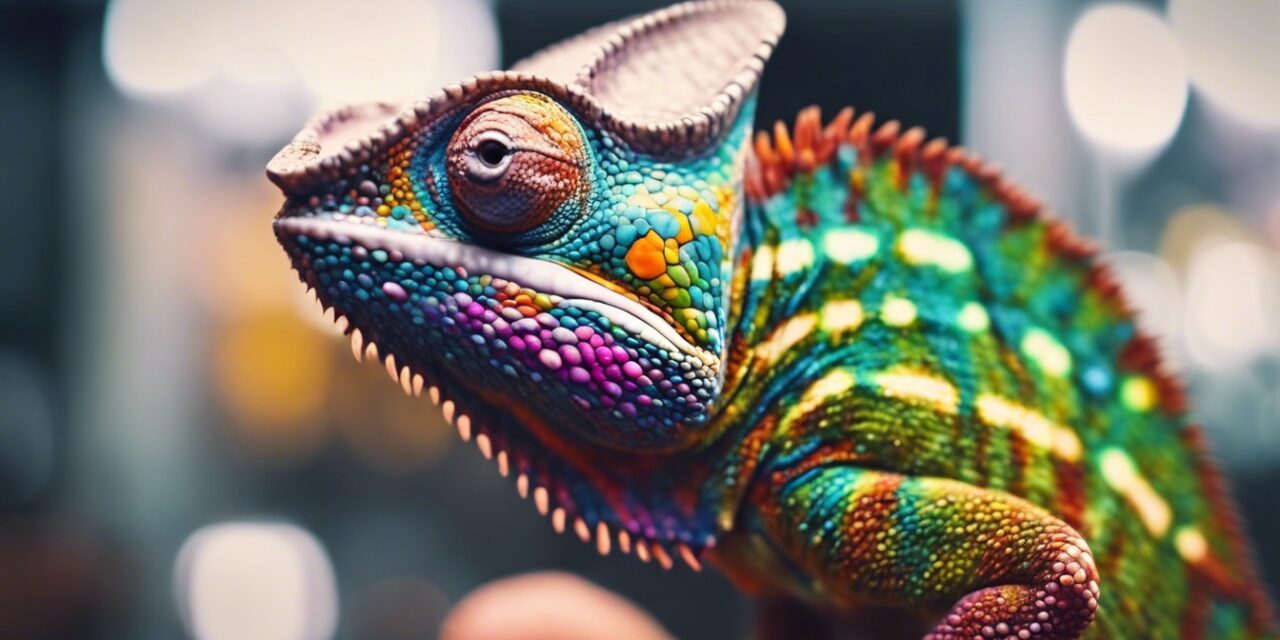The Mesmerizing World of Chameleons
Chameleons, fascinating reptiles known for their unique color-changing abilities, have captivated the imagination of nature enthusiasts and reptile lovers alike. These remarkable creatures belong to the lizard family and are renowned for their ability to change colors in a mesmerizing display. Chameleons are often associated with vibrant hues and intricate patterns that adorn their skin, making them truly captivating to observe.
As color-changing creatures, chameleons possess an extraordinary talent that sets them apart from other reptiles. Their ability to alter their appearance is not merely for aesthetic purposes but serves various important functions in their lives. Through their remarkable color-changing abilities, chameleons communicate with each other, regulate their body temperature, and most notably, camouflage themselves within their surroundings.
Chameleons are masters of disguise, blending seamlessly into their environment by adapting the colors and patterns on their skin to match their surroundings. This incredible adaptation allows them to hide from predators or ambush unsuspecting prey. Whether it’s blending with lush green foliage or mimicking the bark of a tree trunk, chameleons have perfected the art of camouflage.
These color-changing abilities make chameleons one of the most intriguing creatures in the animal kingdom. Their unique talent has sparked curiosity and fascination among researchers and scientists who strive to unravel the mysteries behind this mesmerizing phenomenon. By delving deeper into the science behind chameleon color transformation, we can gain a better understanding of these captivating reptiles and appreciate the wonders of nature’s ingenuity.
The Science Behind Color Transformation
Chameleons’ ability to undergo remarkable color transformation is a result of the intricate mechanisms at play within their bodies. Understanding this process sheds light on the fascinating world of these reptiles and their captivating abilities.
Understanding the Mechanism
The process of color transformation in chameleons is a complex and fascinating one. It involves specialized skin cells called chromatophores, which are responsible for the pigmentation changes observed in these reptiles. Chromatophores contain different pigments that reflect or absorb light, allowing chameleons to alter their appearance.
During color change, the specialized skin cells expand or contract, causing the pigments within them to redistribute. This redistribution leads to variations in color intensity and pattern across the chameleon’s body. By manipulating the distribution of pigments, chameleons can achieve a wide range of colors and patterns, enabling them to blend seamlessly with their surroundings.
The Role of Chromatophores
Chromatophores play a crucial role in enabling chameleons to change color. These specialized skin cells come in various types, each with its own function. The three main types of chromatophores found in chameleons are melanophores, xanthophores, and iridophores.
Melanophores are responsible for producing dark brown or black pigments called melanin. When these pigment-containing cells expand or contract, they influence the darkness or lightness of the chameleon’s skin color. Xanthophores produce yellow and orange pigments known as carotenoids, contributing to vibrant hues seen in some species of chameleons. Iridophores contain reflective structures that create structural colors such as blues and greens when light interacts with them.
By coordinating the activity of these different chromatophore types, chameleons can achieve precise control over their coloration. This intricate interplay between specialized skin cells allows them to adapt their appearance based on environmental factors and internal cues.
Chromatophores: The Specialized Skin Cells
Chromatophores are the key players behind the mesmerizing color-changing abilities of chameleons. These specialized skin cells have unique structures and functions that allow them to respond to external stimuli and regulate color intensity.
An In-depth Look
To truly appreciate the wonders of chromatophores, let’s delve into their structure and function. Chromatophores consist of pigment-containing cells embedded within the chameleon’s skin. These pigment cells are connected to muscles, allowing them to expand or contract in response to various signals.
When a chameleon encounters a change in its environment, such as different lighting conditions or the presence of a potential mate or predator, the chromatophores receive these cues and initiate color adjustments. Through intricate cellular mechanisms, pigments within the chromatophores redistribute, altering the appearance of the chameleon’s skin.
Color Regulation
Chromatophores play a vital role in regulating color intensity in chameleons. By adjusting their size and distribution, these specialized skin cells can control how much light is reflected or absorbed by pigments. This regulation allows chameleons to achieve precise color matching with their surroundings or display vibrant hues during social interactions.
The activity of chromatophores is influenced by various factors, including temperature, humidity, stress levels, and hormonal changes. For example, higher temperatures can stimulate chromatophore activity and result in more intense colors. Conversely, cooler temperatures may cause chromatophores to contract and reduce color expression.
Chameleons also have some voluntary control over their color-changing abilities. They can consciously adjust their body temperature or alter their emotional state to trigger specific responses from their chromatophores. This remarkable ability showcases the intricate connection between a chameleon’s physiology and its external environment.
Understanding how chromatophores function and regulate color provides us with insight into the complex mechanisms that enable chameleons’ captivating transformations.
Pigments: The Key to Vibrant Colors
The vibrant colors displayed by chameleons are made possible by a variety of pigments that exist within their specialized skin cells. These pigments play a crucial role in the color manipulation and alteration observed in these fascinating reptiles.
Exploring Pigment Types
Chameleons possess different types of pigments that contribute to their stunning array of colors. One of the primary pigments found in their skin is melanin, which is responsible for producing dark brown or black hues. Melanin plays a vital role in creating patterns and shading on the chameleon’s body.
In addition to melanin, chameleons also utilize carotenoids as coloring agents. Carotenoids produce vibrant yellow and orange hues, adding an extra dimension to the chameleon’s color palette. These pigments are obtained through the chameleon’s diet, with certain insects and plants serving as rich sources of carotenoids.
Structural colors are another fascinating aspect of chameleon pigmentation. Unlike other pigments, structural colors are not produced by specific molecules but rather arise from the interaction of light with specialized structures within the chromatophores. This interaction results in optical effects that create iridescent blues and greens seen in some species of chameleons.
Color Manipulation
Chameleons have remarkable control over pigment distribution within their chromatophores, allowing them to manipulate their coloration with precision. By expanding or contracting specific chromatophores, they can alter the amount and arrangement of pigments on their skin.
Environmental factors also influence pigment expression in chameleons. Light intensity, temperature, humidity levels, and even emotional states can impact how vividly or subtly a chameleon displays its colors. For example, under bright sunlight, a chameleon may exhibit more intense hues to enhance its camouflage capabilities or communicate its dominance to rivals.
The ability to manipulate pigment distribution enables chameleons to adapt quickly to changing environmental conditions and communicate effectively with others of their kind.
Color as a Language of Chameleons
Chameleons have evolved a unique way of communicating with each other through the use of color. Their ability to change hues and patterns plays a significant role in social interactions and conveying important messages within their species.
Communicating Through Color
Color displays in chameleons serve as a means of communication, allowing them to convey various messages to their counterparts. During courtship rituals, males often exhibit vibrant and contrasting colors to attract potential mates. These displays signal their reproductive fitness and dominance, indicating their suitability as partners.
In territorial disputes or confrontations with rivals, chameleons may display aggressive coloration, such as darkening or intensifying certain hues. This serves as a warning signal to competitors, indicating that they should back off or risk engaging in combat.
Color changes can also be used for more subtle forms of communication. For example, chameleons may adjust the intensity or pattern of their colors to indicate submission or appeasement when faced with a dominant individual. This helps maintain social harmony within their communities.
Emotional Significance
Beyond communication, color changes in chameleons can also reflect their emotional state and behavior. Brighter colors may indicate excitement or aggression, while darker colors might signify fear or stress. These emotional cues are essential for understanding the internal states of these reptiles and interpreting their intentions.
For instance, when threatened by predators, chameleons may rapidly change from vibrant colors to duller shades or even blend into their surroundings through camouflage. This adaptive response allows them to avoid detection and increase their chances of survival.
By observing the intricate dance of colors displayed by chameleons, researchers gain valuable insights into the behavioral dynamics and social hierarchies within these fascinating creatures’ communities.
Camouflage: The Art of Blending In
Chameleons are masters of camouflage, using their remarkable color-changing abilities to blend seamlessly with their surroundings. This art of disguise provides them with adaptive advantages and serves as a crucial survival strategy.
Mastering Camouflage Techniques
Chameleons have evolved various techniques to achieve effective camouflage. By adjusting the distribution and intensity of pigments within their chromatophores, they can match the colors and patterns of their environment. Whether it’s imitating the vibrant green leaves of a tree or mimicking the texture and coloration of a branch, chameleons can disappear into their surroundings, making them nearly invisible to predators and prey alike.
Their ability to change colors rapidly allows them to adapt to different backgrounds as they move through diverse habitats. This versatility in camouflage ensures that chameleons remain hidden from potential threats while hunting for food or seeking shelter.
Survival Strategies
Color-changing plays a vital role in chameleon survival. By blending in with their environment, these reptiles can avoid detection by predators. When threatened, chameleons may adopt defensive tactics such as darkening their skin or displaying bold warning colors to deter potential attackers.
In addition to visual camouflage, chameleons also employ other defense mechanisms. They have specialized body shapes that allow them to blend in with specific types of foliage or bark textures. Some species even have protrusions on their bodies that resemble thorns or branches, further enhancing their disguise.
By utilizing these survival strategies and adapting their appearance based on environmental cues, chameleons increase their chances of survival in challenging ecosystems where they reside.
Unlocking the Wonders of Chameleon Color-Changing
The remarkable ability of chameleons to change color is truly awe-inspiring. Through their intricate mechanisms of color transformation and adaptation, these reptiles have captivated the fascination of nature enthusiasts and researchers alike.
Appreciating the wonders of chameleon color-changing allows us to gain insight into the various purposes and functions it serves. From communication and emotional expression to camouflage and survival strategies, color transformation plays a vital role in the lives of these unique creatures.
By unlocking the secrets behind chameleon color-changing, we can better understand the complexity and beauty of nature’s adaptations. The specialized skin cells called chromatophores, along with different pigments and environmental cues, work together harmoniously to create a mesmerizing display of colors that enable chameleons to thrive in their diverse habitats.
As we delve into the science behind their abilities, we gain a deeper appreciation for the intricacies of chameleon biology. Their color-changing not only serves practical purposes but also showcases nature’s ingenuity and adaptability.
In conclusion, chameleons are living marvels that remind us of the incredible diversity found in our natural world. Their ability to transform their appearance through color adaptation is a testament to their survival skills and evolutionary success. By unraveling the mysteries behind chameleon color-changing, we unlock a deeper understanding of these fascinating reptiles and the wonders they hold within their vibrant skin.










Recent Comments